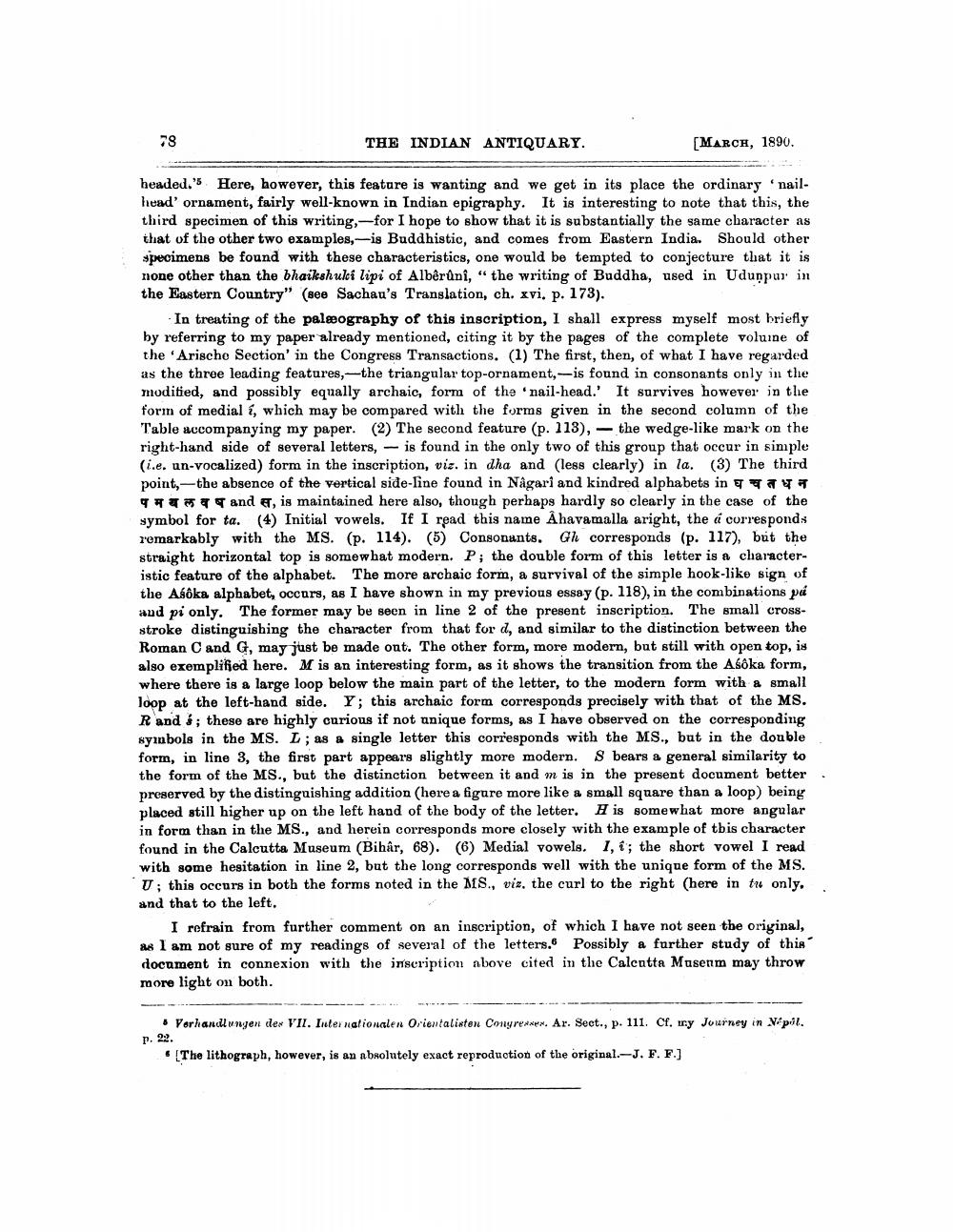________________
78
THE INDIAN ANTIQUARY.
[MARCH, 1890.
headed.' Here, however, this feature is wanting and we get in its place the ordinary nailhead' ornament, fairly well-known in Indian epigraphy. It is interesting to note that this, the third specimen of this writing, for I hope to show that it is substantially the same character as that of the other two examples,-is Buddhistic, and comes from Eastern India. Should other specimens be found with these characteristics, one would be tempted to conjecture that it is none other than the bhaikshuki lipi of Albêrûnî, "the writing of Buddha, used in Uduppur in the Eastern Country" (see Sachau's Translation, ch. xvi. p. 173).
In treating of the paleography of this inscription, I shall express myself most briefly by referring to my paper already mentioned, citing it by the pages of the complete volume of the 'Arische Section' in the Congress Transactions. (1) The first, then, of what I have regarded as the three leading features, the triangular top-ornament,-is found in consonants only in the modified, and possibly equally archaic, form of the 'nail-head.' It survives however in the form of medial í, which may be compared with the forms given in the second column of the Table accompanying my paper. (2) The second feature (p. 113), the wedge-like mark on the right-hand side of several letters, is found in the only two of this group that occur in simple (i.e. un-vocalized) form in the inscription, viz. in dha and (less clearly) in la. (3) The third point, the absence of the vertical side-line found in Nagari and kindred alphabets in
and, is maintained here also, though perhaps hardly so clearly in the case of the symbol for ta. (4) Initial vowels. If I read this name Ahavamalla aright, the á corresponds remarkably with the MS. (p. 114). (5) Consonants. Gh corresponds (p. 117), but the straight horizontal top is somewhat modern. P; the double form of this letter is a characteristic feature of the alphabet. The more archaic form, a survival of the simple hook-like sign of the Asôka alphabet, occurs, as I have shown in my previous essay (p. 118), in the combinations pá and pi only. The former may be seen in line 2 of the present inscription. The small crossstroke distinguishing the character from that for d, and similar to the distinction between the Roman C and G, may just be made out. The other form, more modern, but still with open top, is also exemplified here. M is an interesting form, as it shows the transition from the Asôka form, where there is a large loop below the main part of the letter, to the modern form with a small loop at the left-hand side. Y; this archaic form corresponds precisely with that of the MS. Rand; these are highly curious if not unique forms, as I have observed on the corresponding symbols in the MS. L; as a single letter this corresponds with the MS., but in the double form, in line 3, the first part appears slightly more modern. S bears a general similarity to the form of the MS., but the distinction between it and m is in the present document better preserved by the distinguishing addition (here a figure more like a small square than a loop) being placed still higher up on the left hand of the body of the letter. His somewhat more angular in form than in the MS., and herein corresponds more closely with the example of this character found in the Calcutta Museum (Bihâr, 68). (6) Medial vowels. I, t; the short vowel I read with some hesitation in line 2, but the long corresponds well with the unique form of the MS. U; this occurs in both the forms noted in the MS., viz. the curl to the right (here in tu only. and that to the left.
-
-
I refrain from further comment on an inscription, of which I have not seen the original, as I am not sure of my readings of several of the letters. Possibly a further study of this document in connexion with the inscription above cited in the Calcutta Museum may throw more light on both.
p. 22.
Verhandlungen des VII. Internationalen Orientalisten Congresses. Ar. Sect., p. 111. Cf. my Journey in Népôl. [The lithograph, however, is an absolutely exact reproduction of the original.-J. F. F.]




